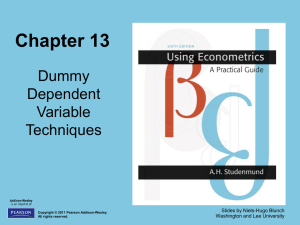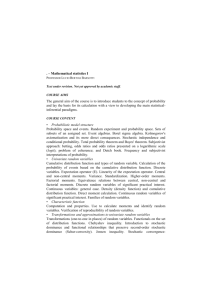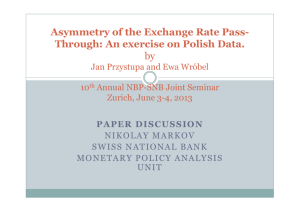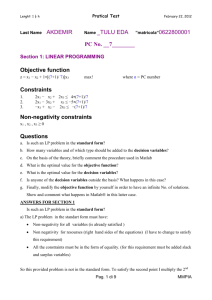ARTIFICIAL NEURAL NETWORKS FOR CLASSIFICATION OF SOUVENIR DESIGNS K
advertisement
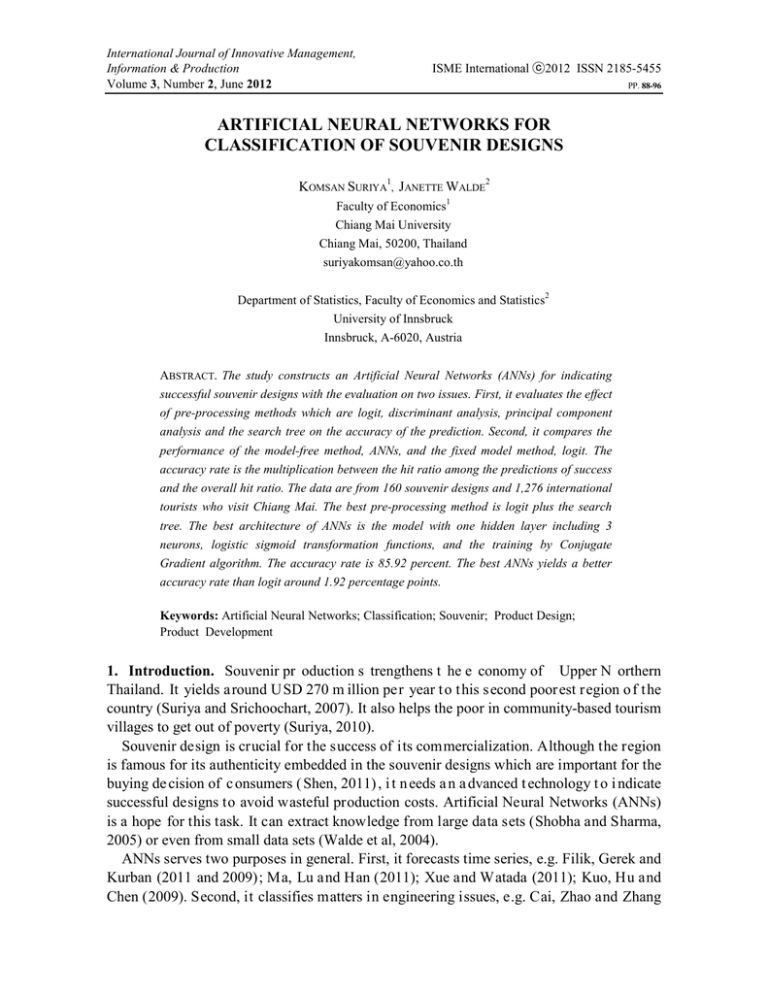
International Journal of Innovative Management, Information & Production Volume 3, Number 2, June 2012 ISME International ⓒ2012 ISSN 2185-5455 PP. 88-96 ARTIFICIAL NEURAL NETWORKS FOR CLASSIFICATION OF SOUVENIR DESIGNS KOMSAN SURIYA1, JANETTE WALDE2 Faculty of Economics1 Chiang Mai University Chiang Mai, 50200, Thailand suriyakomsan@yahoo.co.th Department of Statistics, Faculty of Economics and Statistics2 University of Innsbruck Innsbruck, A-6020, Austria ABSTRACT. The study constructs an Artificial Neural Networks (ANNs) for indicating successful souvenir designs with the evaluation on two issues. First, it evaluates the effect of pre-processing methods which are logit, discriminant analysis, principal component analysis and the search tree on the accuracy of the prediction. Second, it compares the performance of the model-free method, ANNs, and the fixed model method, logit. The accuracy rate is the multiplication between the hit ratio among the predictions of success and the overall hit ratio. The data are from 160 souvenir designs and 1,276 international tourists who visit Chiang Mai. The best pre-processing method is logit plus the search tree. The best architecture of ANNs is the model with one hidden layer including 3 neurons, logistic sigmoid transformation functions, and the training by Conjugate Gradient algorithm. The accuracy rate is 85.92 percent. The best ANNs yields a better accuracy rate than logit around 1.92 percentage points. Keywords: Artificial Neural Networks; Classification; Souvenir; Product Design; Product Development 1. Introduction. Souvenir pr oduction s trengthens t he e conomy of Upper N orthern Thailand. It yields around USD 270 m illion per year t o t his s econd poor est region o f t he country (Suriya and Srichoochart, 2007). It also helps the poor in community-based tourism villages to get out of poverty (Suriya, 2010). Souvenir design is crucial for the success of its commercialization. Although the region is famous for its authenticity embedded in the souvenir designs which are important for the buying de cision of c onsumers ( Shen, 2011) , i t n eeds a n a dvanced t echnology t o i ndicate successful designs to avoid wasteful production costs. Artificial Neural Networks (ANNs) is a hope for this task. It can extract knowledge from large data sets (Shobha and Sharma, 2005) or even from small data sets (Walde et al, 2004). ANNs serves two purposes in general. First, it forecasts time series, e.g. Filik, Gerek and Kurban (2011 and 2009); Ma, Lu and Han (2011); Xue and Watada (2011); Kuo, Hu and Chen (2009). Second, it classifies matters in engineering issues, e.g. Cai, Zhao and Zhang ARTIFICIAL NEURAL NETWORKS FOR CLASSIFICATION OF SOUVENIR DESIGNS 89 (2011); Li, Liu and He (2011); He, et al (2010); Li et al (2010 and 2005); Yu, Yan and Li (2010); Vachkov ( 2006); Machowski and M arwala ( 2005); Motoki, K oakutsu a nd H irata (2005). Moreover, ANNs is useful for the classification in medical aspects, e.g. Tanprasert and Tanprasert (2011); Takeda, Shiraishi and Sanechika (2007); Kim et al (2006). Finally, it classifies consumer’s decision in marketing issues, e.g. Li, Liu and Yang (2011); Wang, Chen and Zhang (2010); Chou, et al (2009) and Suriya and Prukrudee (2006). This s tudy t ries t o c onstruct B ack P ropagation Artificial N eural N etworks to classify successful and unsuccessful souvenir designs in the market of international tourists visiting Upper Northern Thailand. It focuses on two issues. First, As Bishop (2005) mentioned that an a ppropriate pr e-processing m ethod could l ift t he a ccuracy r ate f or the pr ediction of ANNs, the s tudy eva luates t he ef fect of pr e-processing m ethods which a re l ogit, discriminant analysis, principal component analysis and the search tree on t he accuracy of the prediction. Second, it compares the performance of the model-free method, ANNs, and the fixed model method, logit. 2. Experiments on Pre-Processing Methods. The ba se c ase of t he experiment i s A NNs without pre-processing method. There are four experiments to evaluate the effects of p reprocessing m ethods on t he a ccuracy of A NNs’ pr ediction; l ogit, di scriminant a nalysis, principal component analysis and the search tree. Each e xperiment w ill c onstruct B ack P ropagation A NNs w ith one hi dden l ayer. It w ill investigate t he effects of di fferent s igmoid t ransformation f unctions, t ansig and l ogsig. It will f igure out t he p erformance us ing di fferent t raining a lgorithm, Levenberg-Marquardt (LM), Conjugate Gradient (CGF) and Scaled Conjugate Gradient (SCG). The t raining a nd v alidation s ets a re b alanced between s uccessful and uns uccessful souvenir de signs. T here a re 80 a nd 30 de signs i n e ach s et. H owever, the t esting s et i s imbalanced with only 9 successful designs out of 50 designs. The opt imal num ber of ne urons i n t he hi dden layer c an be obt ained by varying t he number from 2 t o 15 a nd measuring the Mean Squared Error (MSE) of each model. Then, the model with minimum MSE will indicate the optimal number of neurons. 3. Comparison between ANNs and Logit. This section will compare the performance of the predictions by ANNs and logit. The best ANNs from the previous section will compete with a logit model which includes all dichotomous input variables, -1 or 1. Logit will use only significant variables for its prediction. ANNs and logit model primarily use 18 i nput variables as listed in table 1. The accuracy index is the multiplication between the hit ratio among the predictions of success a nd t he ove rall hi t r atio. T hen di vide i t b y 100 t o m ake i t a s t he pe rcentage a s follows: Accuracy rate = (Hit ratio among the predictions of success × Overall hit ratio) ÷ 100 The hi t r atio a mong t he pr edictions o f s uccess is w hen A NNs p redicts t hat a s ouvenir design is successful and that prediction is correct. The overall hit ratio is the ratio of correct predictions to all predictions. 90 KOMSAN SURIYA AND JANETTE WALDE This me asurement is to avoid the be nefits f rom the s trategies of p redicting onl y successful, onl y uns uccessful and half s uccessful out comes. T he m ore o utcomes t hat t he model da res t o predict s uccessful d esigns a nd c orrect, t he hi gher a ccuracy i ndex w ill be achieved. TABLE 1. Description of input variables CODE DESCRIPTION 1 HANDMADE Made by hand 2 WOOD Made of wood 3 CLOTH Mode of clothe 4 SILVER Made of silver 5 NATRMATR Made of natural materials 6 NATURE The design is inspired by nature 7 LANNA Lanna (Northern Thai) style 8 THAI Thai style 9 ELEPH Contains something related to elephant 10 SMALL Small size 11 LIGHT Light weight 12 TOLERENC Not fragile 13 ROUND Round shape 14 FOLD foldable 15 PACK Sold more than 1 piece at a time 16 USE Function, not just decoration 17 BODY Usable with human body 18 COLLECT Collectible as collections Note: All variables are binary choices with the value of -1 and 1. For t he da ta c ollection, c atalogues of 160 s ouvenir de signs w ere pr esented t o 1,276 international tourists in the domestic departure lounge at Chiang Mai International Airport. A tourist chose two favorite designs from the catalogue. Successful deigns were defined as the de signs w ith more th an 10 times of be ing chos en. The r est w as cl assified as unsuccessful designs. 4. Results. The f ollowing s ection presents t he r esults f rom t he pr ediction of A NNs w ith variety of pre-processing methods. 4.1 Classification without Data Pre-Processing. ANNs without pr e-processing m ethod uses 18 input variables. The result in table 2 shows that the model yields only around 12.35 to 14.60 percent of accuracy. The best model in this class is ANNs with one hidden layer, 3 neurons, t an-sigmoid (tansig) tr ansformation f unction i n t he hi dden l ayer, t he l ogistic sigmoid ( logsig) t ransformation f unction i n t he out put layer a nd t raining LevenbergMarquardt (LM). ARTIFICIAL NEURAL NETWORKS FOR CLASSIFICATION OF SOUVENIR DESIGNS 91 TABLE 2. The performance of ANNs without data pre-processing Transformation function Training Hit ratio among the Overall hit predictions of success ratio Accuracy rate Tansig, Logsig LM 23.54 62.02 14.60 Logsig, Logsig LM 22.88 60.44 13.83 Tansig, Logsig SCG 21.93 60.58 13.29 Logsig, Logsig CGF 20.94 60.52 12.67 Tansig, Logsig CGF 21.02 59.62 12.53 Logsig, Logsig SCG 20.7 59.66 12.35 Source: Calculation using Matlab 4.2. Classification with Pre-Processing Using Logit. After us ing l ogit a s t he pr eprocessing method, ANNs improves its accuracy rate to 32.36 percent. The overall hit ratio of the model improves to around 80 percent. However, the hit ratio among the predictions of success is lower than 50 percent. The best ANNs in this class uses only 5 variables. It includes one hi dden l ayer, 3 ne urons, l ogistic s igmoid t ransformation f unctions i n bot h hidden and output layer, and training with CGF algorithm. TABLE 3. The performance of ANNs with data pre-processing using logit Transformation Training Inputs function Hit ratio among the Overall hit Accuracy predictions of ratio rate success Logsig, logsig CGF 5 40.15 80.60 32.36 Tansig, logsig CGF 5 40.11 80.02 32.10 Tansig, logsig LM 5 38.27 80.24 30.71 Logsig, logsig LM 5 33.87 80.36 27.22 Source: Calculation using Matlab 4.3. Classification with Pre-Processing Using Discriminant Analysis. ANNs w ith the discriminant a nalysis a s the pr e-processing m ethod yields t he l owest a ccuracy rate, 3.46 percent. Both the hit ratio among the predictions of success and the overall hit ratio are low. TABLE 4. The performance of ANNs with data pre-processing using discriminant analysis Transformation Training Neurons function Hit ratio Overall hit among the ratio Accuracy rate predictions of success Logsig,logsig CGF 5 15.95 Source: Calculation using Matlab 21.72 3.46 92 KOMSAN SURIYA AND JANETTE WALDE 4.4. Classification with Pre-Processing Using Principal Component Analysis. The principal c omponent analysis as a p re-processing m ethod s lightly i mproves t he performance of ANNs. The accuracy r ates are a round 12.55 t o 17.21 pe rcent. Varimax i s the best strategy among rotation strategies. TABLE 5. The performance of ANNs with data pre-processing using principal component analysis Rotations Training Neurons Hit ratio among Overall hit the predictions of ratio Accuracy rate success Varimax Quatimax Equamax None CGF CGF CGF CGF 6 3 7 12 26.89 20.57 21.16 21.41 64.0 61.8 60.0 58.6 17.21 12.71 12.70 12.55 Source: Calculation using Matlab 4.5. Classification with Pre-Processing Using the Search Tree. In s earch of t he m ost important variables to the dependent variable, five significant input variables from logit are included into the experiments. Then the search tree will combine two variables and find the performance of using the pair as the input variables of ANNs. TABLE 6. The performance of ANNs with data pre-processing using logit plus the search tree Input variable Input variable Hit ratio among the Overall hit 1 2 predictions of ratio Accuracy rate success Elephant Small 50.00 82.00 41.00 Elephant Tolerance 17.31 20.24 3.50 Elephant Pack 20.37 26.60 5.42 Elephant Collectible 100.00 85.92 85.92 Small Tolerance 0.37 76.88 0.28 Small Pack 0.77 76.04 0.59 Small Collectible 0.00 78.08 0.00 Tolerance Pack 17.91 24.02 4.30 Tolerance Collectible 17.05 20.56 3.51 Pack Collectible 19.53 26.40 5.16 Source: Calculation using Matlab Note: The architecture of ANNs includes one layer with 3 neurons, logistic sigmoid (logsig) transformation functions and training CGF. ARTIFICIAL NEURAL NETWORKS FOR CLASSIFICATION OF SOUVENIR DESIGNS 93 The pa ir of v ariables Elephant a nd Collect yields the hi ghest hi t r atio among th e predictions of success as well as the overall hit ratio. Moreover, the accuracy rate is high, 85.92. T his i s t he f irst model t hat t he hi t r atio among t he pr edictions of s uccess i s 100 percent. 4.6. Comparison between ANNs and Logit. Logit model predicts the successful souvenir designs by using only 5 significant variables with their coefficients in that model. Table 7 presents the e stimation results of log it mod els w ith all 18 input v ariables a nd onl y significant variables which are Elephant, Small, Tolerance, Pack and Collect. TABLE 7. Estimation result from logit (input values are in -1 and 1 while output variable is 0 and 1) (2) (1) Variables Full model Standard error Model with significant Standard error variables ELEPH 0.6591* 0.3610 0.6921** 0.3371 SMALL 0.4782* 0.2539 0.4749** 0.2054 LIGHT -0.2012 0.5208 TOLERENC 1.1444** 0.5760 0.9623* 0.5330 ROUND -0.1316 0.3574 FOLD 0.2586 0.2379 PACK -1.3564** 0.6811 -1.0810* 0.5892 USE 0.9950 0.7060 BODY 0.0563 0.2117 0.6819** 0.3318 -1.5444** 0.7597 COLLECT 1.5482** 0.6790 HANDMADE -0.1309 0.2797 WOOD -0.0107 0.2356 CLOTH -0.2646 0.2613 SILVER 0.3501 0.3582 NATRMATR 0.1415 0.2337 NATURE 0.2691 0.2199 LANNA 0.6334 0.4823 THAI 0.2944 0.5484 C -0.5067 1.0315 Source: Calculation using Eviews Note: Number in the bracket is standard error. *** Significant at 99%, ** Significant at 95%, * Significant at 90% 94 KOMSAN SURIYA AND JANETTE WALDE The performances of logit and the best ANNs are quite similar. ANNs is superior by only 1.92 percentage points. Their differences come from the overall hit ratio while both of them yields the same 100 percent of the hit ratio among the predictions of success. TABLE 8. Comparison the performance of ANNs and logit Model Input Specification variables Hit ratio Overall hit among the ratio Accuracy rate predictions of success The 2 variables One hidden layer with 3 best neurons, logsig and ANNs training by CGF algorithm Logit 5 significant The values of input variables variables are either -1 or 1. 100 85.92 85.92 100 84.00 84.00 Source: Calculation using Matlab and Eviews 5. Discussions. ANNs without data pre-processing takes too much variables into the model. Most of these variables are proven that they give little information for the prediction. Logit helps i mproving t he a ccuracy of t he m odel b y reducing t he num ber of va riable i n a reasonable w ay. T he s igns of s ignificant v ariables f rom l ogit m odel are explainable w ith stories i n r eality. T he di scriminant a nalysis a nd principal c omponent a nalysis yields l ess accuracy r ate t han logit pr obably be cause t hey just r educe t he num ber of va riables but cannot explain the reasons behind the remaining variables. ANNs using the search tree as the pre-processing method yields the best accur acy r ate. However, t he s earch t ree doe s not work alone in this e xperiment. It us es s ignificant variables from logit model. Therefore, it is a combination of logit and the search tree that makes ANNs superior than logit. 6. Conclusions. The be st pr e-processing m ethod i s l ogit pl us t he s earch t ree. T he be st architecture of A NNs i s t he m odel w hich us es one hi dden l ayer i ncluding 3 ne urons, logistic sigmoid transformation functions, and the training by Conjugate Gradient algorithm. The accuracy index is 85.92 percent. The best ANNs yields a better accuracy rate than logit around 1.92 percentage points. Acknowledgment. The authors would like to thank National Research Council of Thailand, Austrian Exchange S ervice (OEAD), and t he C ommission on H igher Education, M inistry of Education, Thailand, for their financial supports to the project. ARTIFICIAL NEURAL NETWORKS FOR CLASSIFICATION OF SOUVENIR DESIGNS 95 REFERENCES [1] C. Bishop (2005), Neural networks for pattern classification, 13th ed, Oxford: Oxford University Press. [2] C. He et al .(2010), Prediction o f d ensity a nd m echanical p roperties in s yntactic f oam using a rtificial neural network, ICIC Express Letters, vol.4, no.6, pp.2383 – 2388. [3] F. Takeda, Y . Shiraishi a nd T . S anechika (2007), Alarm sound c lassification s ystem o f o xygen concentrator by using neural network, International Journal of Innovative Computing, Information and Control, vol.3, no.1, pp.211 – 222. [4] G. T. Shobha, and S. C. Sharma (2005), Knowledge discovery for large data sets using artificial neural network, International Journal of Innovative Computing, Information and Control, vol.1, no.4, pp.635 – 642. [5] G. Vachkov (2006), Growing n eural models for p rocess i dentification an d d ata an alysis, International Journal of Innovative Computing, Information and Control, vol.2, no.1, pp.101 – 123. [6] H. Kim et al .(2006), Automatic j udgement of s pinal de formity ba sed on ba ck p ropagation o n ne ural network, International Journal of Innovative Computing, Information and Control, vol.2, no.6, pp.1271 – 1279. [7] H. Li, J. Liu and C. He (2011), Concrete compressive strength prediction using rebound and core drilling synthetic method through artificial neural networks, ICIC Express Letters, vol.5, no.4, pp.1121 – 1128. [8] H. Li et al .(2005), Crack d amage d etection i n b eam-like s tructure u sing r bf neural networks w ith experimental validation, International Journal of Innovative Computing, Information and Control, vol.1, no.4, pp.625 – 634. [9] Janette F. Walde (2005), Design kuenslicher neuronaler netze: ein leitfaden zur effizienten handhabung mehrschichtiger perzeptrone, Wiesbaden: DUV (in German). [10] Janette F . W alde (2003), Valid s tatistical i nference b ased o n f eedforward a rtificial n eural n etwork models, Proceedings of the Seventh Young Statisticians Meeting, Ljubljana, Slovenia. [11] J. Walde (2007), Valid h ypothesis t esting i n face o f s patially d ependent d ata using multi-layer perceptrons and sub-sampling techniques, Computational Statistics and Data Analysis, vol.51, pp.27012719. [12] J. Walde et al (2004), Statistical aspects of multilayer perceptrons under data limitation, Computational Statistics and Data Analysis, vol.46, no.1, pp.173 - 188. [13] J. Wang, N . Chen a nd K . Z hang (2010), Music e motional cl assification r esearch b ased o n b p n eural network, ICIC Express Letters, no.4, vol.6, pp.2075 – 2079. [14] J. Xue and J. Watada (2011), Short-term power load forecasting method by radical-basis-function neural network with support vector machine model, ICIC Express Letters, vol.5, no.5, pp.1523 – 1528. [15] K. Suriya and S. Prukrudee (2006), The exploration of classification using neural networks: case study of souvenir designs, working paper on artificial neural networks, Chiang Mai: Faculty of Economics and Social Research Institute, Chiang Mai University. [16] K. Suriya a nd S . Srichoochart (2007), The a nalysis a nd d evelopment o f t ourism p roducts a nd s ervices for smes and community enterprises in upper northern thailand, Chiang Mai: Social Research Institute. [17] K. Suriya (2010), An economic analysis of community-based tourism in Thailand, Doctoral dissertation, Faculty of Economics, University of Goettingen. [18] L. A. Machowski, and T. Marwala (2005), Using an object oriented calculation process framework and neural ne tworks f or classification of i mage s hapes, International Journal of Innovative Computing, Information and Control, vol.1, no.4, pp.609 – 623. 96 KOMSAN SURIYA AND JANETTE WALDE [19] M. Motoki, S. Koakutsu and H. Hirata (2005), A pulse neural network incorporating short term synaptic plasticity for engineering applications, International Journal of Innovative Computing, Information and Control, vol.1, no.3, pp.417 – 428. [20] M. Shen (2011), The effects of globalized authenticity on souvenir, International Journal of Innovative Management, Information and Production, vol.2, no.1, pp.68 - 76. [21] P. Chou et al .(2009), Application of ba ck-propagation ne ural ne tworks f or e-commerce cu stomers patterning, ICIC Express Letters, vol.3, no.3, pp.775 - 785. [22] R. Kuo, T . Hu and Z . C hen (2009), Evolutionary a lgorithm for o il p rice f orecasting, ICIC Express Letters, vol.3, no.3B (September), pp.701 – 705. [23] S. Cai, L. Zhao and Z. Zhang (2011), Tool outsourcing risk researching based on bp neural network, International Journal of Innovative Management, Information and Production, vol.2, no.1, pp.57 - 67. [24] T. Tanprasert and C. Tanprasert (2011), Creatinine prediction from body composition: a neural network approach, International Journal of Innovative Management, Information and Production, vol.2, no.1, pp.41 - 48. [25] U. B . Filik, O . N. Gerek a nd M . K urban (2011), Hourly forecasting o f l ong t erm el ectricity e nergy demand using no vel m athematical models an d n eural n etworks, International Journal of Innovative Computing, Information and Control, vol.7, no.6, pp.3545 – 3558. [26] U. B. Filik, O.N.Gerek, M.Krban(2009), Neural and mathematical modeling approaches for hourly long term load forecasting, ICIC Express Letters, vol.3, no.4A (December), pp.1125 – 1130. [27] W. Li, Z. Liu a nd J . Y ang (2011), Marine market f orecasting u sing ex tension ne ural network, ICIC Express Letters, vol.5, no.2, pp. 497 – 502. [28] W. Ma, X . Lu and G . Ha n (2011), Research of pr edictive model of s hort-time tr affic flow based on fuzzy neural networks, ICIC Express Letters, vol.5, no.5, pp.1609 – 1614. [29] X. Yu, Q. Yan and B. Li (2010). Structural reliability analysis of arch bridges based on neural network, Journal of Management Science and Statistical Decision, vol.7, no.1, pp.29 – 34. [30] Y. Li et al (2010), Application of RBF neural network optimized by pso algorithm on condition-based maintenance o f t ransmission a nd t ransformation e quipments, Journal of Management Science and Statistical Decision, vol.7, no.1, pp.118 – 121.
